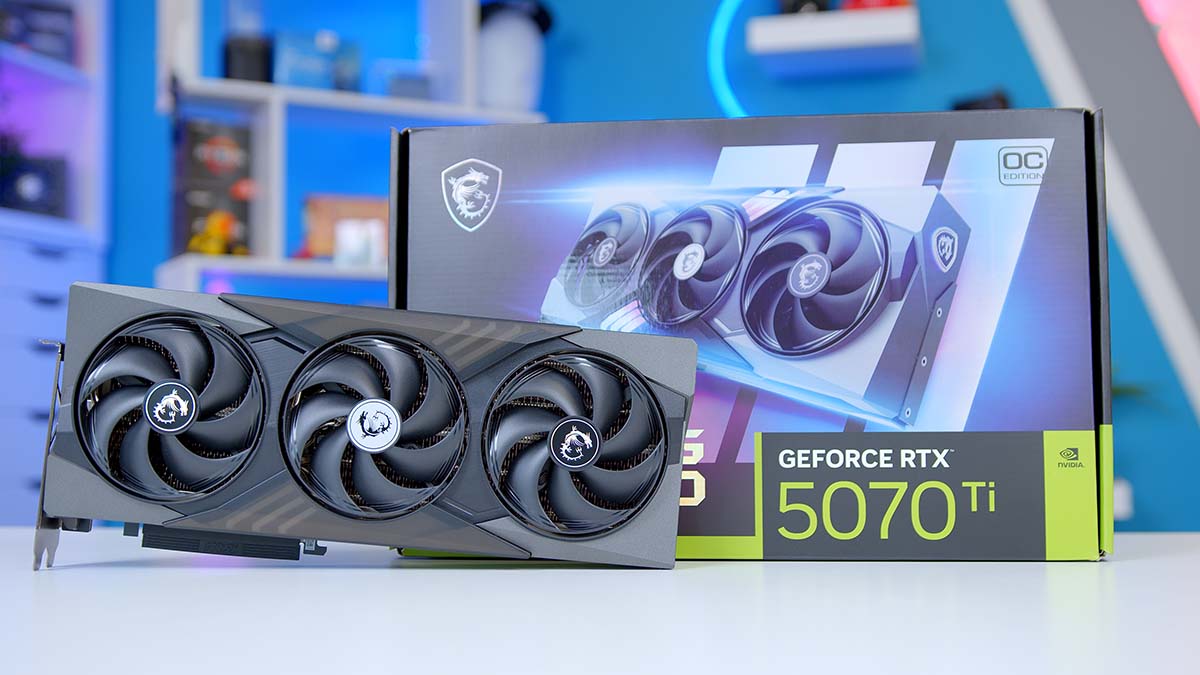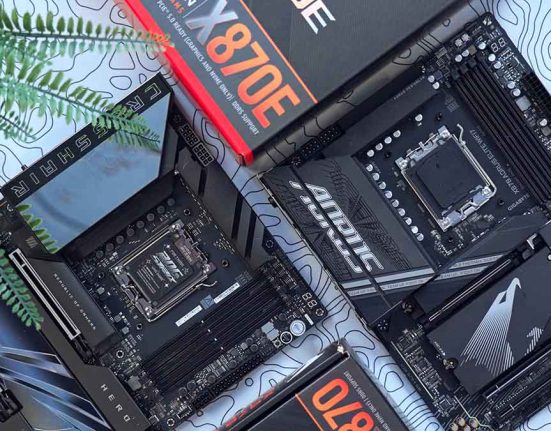The MSI RTX 5070 Ti Gaming Trio OC is one of many AIB graphics cards that hit the shelves with the arrival of the RTX 5070 Ti. Since its launch, the RTX 5070 Ti sold out almost immediately, with distributors and retailers slowly trickling down new pieces of stock as they become available. The RTX 5070 Ti hasn’t received the most positive response, with many calling out NVIDIA for poor pricing, it’s challenging to source an RTX 5070 Ti at its $749 MSRP.
However, the RTX 5070 Ti Gaming Trio OC from MSI isn’t masquerading as an MSRP card. Instead, this is one of MSI’s more premium GPUs that caters to those looking for a nicer design that provides additional performance benefits. This card utilises the all-too-familiar Gaming Trio design with some distinct RGB lighting and a study triple-fan shroud built to keep thermals at bay while offering some performance bumps compared to the small selection of MSRP models.
Despite the general sentiment around the RTX 5070 Ti, this card isn’t as bad as it’s being made out to be. It’s notably better performance-wise than the RTX 4070 Ti SUPER and will continue to improve with driver refinements and updates to technology like DLSS and Frame Generation. NVIDIA’s Blackwell architecture is certainly an improvement compared to Lovelace, which makes it worth considering alone if you’re looking for the best performance money can buy. However, we’ll leave the performance talk until the benchmarks later on.
In this review, we examine the MSI RTX 5070 Ti Gaming Trio OC to see if it’s worth picking up among the many AIBs already available or if its price is too high for most buyers.
Specification
The most significant point of contention for the RTX 5070 Ti is its launch MSRP, which is $749 in the US and £729 in the UK. Unfortunately, we only saw about two graphics cards that launched at this price point, with the rest coming in much higher, putting these cards out of reach for many prospective buyers. While not an MSRP model, the Gaming Trio OC variant is one of the cheaper cards if you can pick it up. Prices hover between $800 and $850 for this card, far better than some of the $1000 versions we saw at launch.

Despite pricing not being quite where we want it to be, the RTX 5070 Ti has a decent set of specs on paper. One of the most notable is its 16GB of GDDR7 VRAM. The previous generation’s RTX 4070 Ti received plenty of criticism due to a lack of VRAM, but with the arrival of the RTX 4070 Ti SUPER, and now the RTX 5070 Ti, 16GB seems to be the norm for this GPU. Additionally, the upgrade to GDDR7 provides more bandwidth than GDDR6X while providing NVIDIA with more room to upgrade the performance of these cards in the future.
| Key Specs | RTX 5080 | RTX 5070 Ti | RTX 4070 Ti SUPER |
|---|---|---|---|
| Video Memory | 16GB GDDR7 | 16GB GDDR7 | 16GB GDDR6X |
| Memory Bus | 256-bit | 256-bit | 256-bit |
| Base Clock Speed | 2.29GHz | 2.3GHz | 2.34GHz |
| Boost Clock Speed | 2.61GHz | 2.45GHz | 2.61GHz |
| CUDA Cores | 10752 | 8960 | 8448 |
| RT Cores | 88 | 70 | 66 |
| Tensor Cores | 336 | 280 | 264 |
| Power Consumption | 360W | 300W | 285W |
| MSRP | $999.99 | $749.99 | $799.99 |
The rest of the specs are, for the most part, similar to those of the RTX 4070 Ti SUPER. Both cards sit on a 256-bit memory bus, have a similar amount of CUDA, RT and Tensor cores, and power consumption has only increased by 15W from 285W to 300W.
One final upgrade worth noting is the AI TOPS performance. NVIDIA has stated previously that this generation of GPUs would not be possible without the modern capabilities of AI, which also includes DLSS and Frame Generation. Frame Generation is particularly worth mentioning, as the latest iteration (Multi-Frame Generation) allows gamers to enjoy smoother gameplay, making it worth using in highly intense titles.
Design
Moving onto the design, the MSI Gaming Trio OC utilises an all-too-familiar design. This is a triple-fan card with a predominantly black plastic shroud that spans the whole width and length of the card. Gaming Trio models are not known for their fancified looks, but they offer plenty of visual flair in the form of RGB, which spices up the look of your build.
Each fan features the MSI dragon logo, and an RGB strip spans the diagonal length of the card towards the centre. You’ll also find additional LEDs on the side and back of the graphics card, which can be synced with the rest of the lighting on the GPU using software like MSI Center.

The Stormforce fans at the front of the card ensure that this GPU remains cool under load. Cool air is pushed through a large heatsink array and fin stack, which passes through a cutout in the backplate. The MSI Gaming Trio OC variant of the RTX 5070 Ti is highly capable of keeping itself cool, and this doesn’t take away from the simplistic but RGB-heavy design that MSI has gone for.

It’s a shame MSI hasn’t gone for RGB fans on this particular card, but we imagine that because this is designed as more of an affordable GPU, the lack of any RGB on the fans is likely due to cost-saving measures. Despite this, I think the design of the MSI Gaming Trio OC variant is generally quite well-rounded. The black shroud and backplate help it blend in with other dark components, and the various RGB LEDs offer an element of customisation catering to a plethora of prospective buyers.
Architecture
Every RTX 5000-series graphics card launched in 2025 has a new version of DLSS (DLSS4). This generation of DLSS features specific improvements that only apply to the RTX 50-series and introduces a new technology called Multi-Frame Generation. DLSS has seen general improvements in performance, including less overhead and better visual quality.
Breaking down Multi-Frame Generation into Layman’s terms, this is essentially a more aggressive form of the original Frame Generation technology that was introduced with the arrival of the RTX 4000. Frame Generation uses AI to draw an additional frame for every rasterised frame, making gameplay smoother and increasing framerates. Multi-Frame Gen creates more (three to be specific) AI-drawn frames to make gameplay a perceivably smoother experience, which is ideal for titles that are particularly choppy or don’t offer great framerates.

Many have called out NVIDIA for creating fake frames, as some gamers see the performance benefit as practically negligible. Multi-Frame Generation is handy in performance-intensive AAA titles, especially when you’re not reaching your display’s output refresh rate. But in multiplayer and cooperative games, this is when Multi-Frame Gen is likely to be avoided by most.
This is due to latency. In the many games that we’ve tested with Multi-Frame Gen, a couple stood out to us. For example, in Cyberpunk 2077, we saw system latency surge to 16ms, which is a reasonably noticeable delay that could impact your gameplay. However, in Hogwarts Legacy, responsiveness sat at 2ms, which is a much palatable response time to deal with. Multi-Frame Gen will be worth avoiding if you’re an Esports or multiplayer FPS gamer to ensure your gameplay and reaction times aren’t hindered. However, if you want to maximise visual quality and performance, Multi-Frame Gen offers a nice performance boost in supported titles.
Performance
As always, all of our benchmarking and testing is done by our in-house benchmarker, Harry Coleman, who has worked tirelessly to gather all the data needed for our RTX 5000 series content. The RTX 5070 Ti and a range of competitor graphics cards have been tested in our primary benchmarking system and paired with the AMD Ryzen 7 9800X3D to provide the best framerates possible across all of the titles we tested. The games featured in this benchmarking section provide a mix of AAA games and modern Esports titles to see how the RTX 5070 Ti holds up in a range of games.
Cyberpunk 2077
Settings: 4K, Shadow Quality High, Indirect Lighting High, Reflections High, Crowd Density High, Particle Quality High, Volumetric Lighting High, Motion Blur off, GTAO Quality High, Grass Quality High, Contact Shadows High VSync Off, DLSS: On/Off, Ray Tracing: On/Off, Textures: High
Starting with Cyberpunk 2077 at 4K high, rasterisation only, the MSI RTX 5070 Ti Gaming Trio OC offered a good baseline result in this benchmark with an 80FPS average, compared to the RTX 4070 Ti SUPER, which sits at a meagre 62FPS. This is a significant jump at 4K, which may put the 5070 Ti in a better market position, targeted as a 4K card if the rest of our benchmarks follow suit.
It’s also worth noting that the RTX 5070 Ti beat out the previous generation’s RX 7900 XTX in this run, a 24GB graphics card. This shows that large amounts of VRAM aren’t always needed to leverage high performance.

After we switched on DLSS, Frame Gen and ray tracing, the MSI RTX 5070 Ti Gaming Trio OC offered an improvement up to 93FPS, which is nearly 15FPS more than the rasterised benchmark. Ray tracing impacts framerates here, so Frame Gen has been added to supplement framerates. The RTX 4070 Ti SUPER in this run didn’t sit particularly far behind, offering a very reasonable 83FPS, just 10FPS less than the RTX 5070 Ti. It may be worth holding onto your RTX 4070 Ti SUPER if you plan on playing intense games.

Alan Wake II
Settings: 4K, Post-Processing High, Texture Resolution High, Texture Filtering High, Volumetric Lighting High, Global Illumination Quality High, Shadow Detail High, Terrain Quality High, Ray-Tracing: Enabled, Ray Tracing Preset High, DLSS: On/Off, Frame Generation: On/Off
In Alan Wake 2 at 4K with rasterised gameplay, the MSI RTX 5070 Ti Gaming Trio OC struggled, outputting an average FPS of 51. Unfortunately, this game isn’t optimised for pure rasterised gameplay, so even cards like the RTX 5090 couldn’t cope entirely. If we look at the output of the RTX 4070 Ti SUPER, framerates are even worse, with this previous generation card sitting at 45FPS.

With DLSS, ray tracing and frame generation enabled, the overall performance isn’t much better. While visual fidelity has significantly increased, Alan Wake 2 is again proving to be one of the most demanding titles to run at 4K, costing gamers plenty of frames. It’s worth considering dumbing down the settings in this title to enjoy higher frames.

Hogwarts Legacy
Settings: 4K, Effects High, Material High, Fog High, Sky High, Foliage High, Post Process High, Shadows High, Textures High, View Distance High, Population High, Anti Aliasing TAA High, Windowed Fullscreen
In Hogwarts Legacy at 4K, the MSI RTX 5070 Ti Gaming Trio OC offered a decent 88FPS, versus the RTX 4070 Ti SUPER, which hovered around 72FPS. Across the board, we’re seeing a decent uplift in performance at 4K, which is great despite how similar these cards are on paper. In this benchmark, the MSI RTX 5070 Ti Gaming Trio OC is beaten by the RX 9070 XT, which is an impressive feat.

Once we switched on DLSS, framerates increased across all the cards we tested. The MSI RTX 5070 Ti Gaming Trio OC sits between the RX 7900 XTX and RTX 4080 with an average framerate of 122FPS. The RX 9070 XT leaps ahead with a solid 94FPS average. This is considerably stronger than the rasterised gameplay, with DLSS providing a 40FPS bump at 4K. Unfortunately, the RTX 4070 Ti SUPER isn’t quite able to catch up, hovering around 107FPS in this title.

Marvel Rivals
Settings: 4K, Graphics Quality High, Global Illumination Lumen GI- High Quality, Reflection Quality Screen Space Reflections, Model Detail High, Post-Processing High, Shadow Detail High, DLSS On/Off, Frame Gen On/Off
Dropping the resolution to 1440p in the hit Esports title Marvel Rivals, the MSI RTX 5070 Ti Gaming Trio OC reached 140FPS in this benchmarking run, which is pretty impressive despite this being just rasterised gameplay. The RTX 4070 Ti SUPER offered somewhat similar performance with a 128FPS average. High framerates are essential in this title, so the RTX 5070 Ti is the more favourable of the two, especially for those with high refresh rate displays.

After we switched on DLSS and Frame Gen, the RTX 5070 Ti’s performance skyrocketed, with this card sitting at a healthy 257FPS. However, the RTX 4070 Ti SUPER is pretty close, offering 234 frames on average. Ultimately, the performance difference won’t be particularly visible at framerates this high. However, it’s great that the RTX 5070 Ti still offers a decent improvement over the RTX 4070 Ti SUPER at 1440p.

COD Black Ops 6
Settings: 1440p, Graphics Preset Custom, Texture Resolution High, Depth of Field On, Detail Quality High, Particle Resolution High, Shader Quality High, Shadow Quality High, Screen Space Shadows High, DLSS On/Off, Frame Gen On/Off
In COD Black Ops 6 Zombies at 1440p high, the MSI RTX 5070 Ti Gaming Trio OC outputs a solid average framerate of 147FPS, followed by the RTX 4070 Ti SUPER sitting at 141FPS. This game is relatively well-optimised, so there isn’t a massive gap between each card we’ve tested. Unfortunately, DLSS doesn’t do much to improve the standings, so it will be better to play this title natively to avoid latency or visual fidelity loss.

Apex Legends
Settings: 1440p, Anti-aliasing TSAA, Texture Filtering 8X, Model Detail High, VSync Disabled, Effects High, Ambient Occlusion Quality High
Our penultimate benchmarking run was Apex Legends, maintaining the resolution of 1440p. Unsurprisingly, the MSI RTX 5070 Ti Gaming Trio OC in this title maxed out the framerate. Despite unlocking the FPS, Apex Legends has a cap of 300FPS, and the RTX 5070 Ti sits at 298FPS, so there’s not much more to be gained here. The RTX 4070 Ti SUPER loses out by about 10FPS in this benchmark, but again, at framerates this high, you won’t notice a difference in framerates.

Fortnite
Settings: 1080p, Competitive, View Distance Far, FPS Unlimited, VSync Off, Anti-Aliasing TAA, Shadows Off, Reflections Off, Textures Low
Last is the hit battle royale Fortnite, where we dialled the resolution to 1080p and the settings to low. This benchmark isn’t really used to test performance, but it gives us an idea of where each generation lands. In this particular benchmark, the MSI RTX 5070 Ti Gaming Trio OC offered up 405FPS, which is oddly weaker than the RTX 4070 Ti SUPER at 433FPS. This could be down to drivers or other factors, but we’re not worried that the RTX 5070 Ti will struggle purely based on how ridiculous the results are at 1080p.

Conclusion
MSI RTX 5070 Ti Gaming Trio OC
Product Name: RTX 5070 Ti Gaming Trio OC
Brand: MSI
-
Features
-
Design
-
Performance
-
Value For Money
Summary
The MSI RTX 5070 Ti Gaming Trio OC is a solid graphics card for 4K gaming. It offers gamers a great-looking GPU with a triple-fan shroud designed to handle thermals from intense gaming workloads. Compared to the previous generation’s RTX 4070 Ti SUPER, the RTX 5070 Ti is the better card of the two, offering a decent generational performance bonus, especially when you throw DLSS and Frame Generation into the mix.
However, the outlying problem with this card, and all RTX 5070 Tis, is stock, pricing, and, more recently, the RX 9070 XT. To keep this brief, the RTX 5070 Ti is far too expensive and has little available stock. This means all the gamers on launch who wanted one picked up the MSRP options, leaving behind the more expensive variants for everyone else. Additionally, with the release of the RX 9070 XT in March of 2025, the RTX 5070 Ti has a strong competitor at a highly reasonable price point. While I don’t think the MSI Gaming Trio OC is a poor card by any means, it’s joined an incredibly tough market. If you like RGB lighting and are looking for a card with decent cooling, the Gaming Trio OC is a solid option, but keep in mind you’ll be spending more than MSRP.
Pros
✅ Great 4K performance
✅ Plenty of RGB lighting
✅ Able to utilise DLSS4
Cons
❌ Difficult to source
❌ Expensive
❌ RX 9070 XT as competition








![FI_[DM78] Corsair Air 5400 + 5090 Gaming PC Build](https://geekawhat.com/wp-content/uploads/2025/11/FI_DM78-Corsair-Air-5400-5090-Gaming-PC-Build-551x431.jpg)